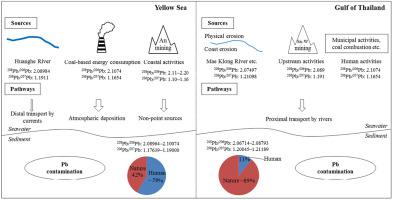Chemical Geology ( IF 3.9 ) Pub Date : 2022-07-30 , DOI: 10.1016/j.chemgeo.2022.121046 Bin Wu , Xiaodan Wu , Shuqing Qiao , Xuefa Shi , Limin Hu , Jinming Song , Xuegang Li , Shengfa Liu , Jihua Liu , Yazhi Bai , Jun Zhang , Aimei Zhu , Narumol Kornkanitnan , Somkiat Khokiattiwong

|
Anthropogenic emissions from coal-petroleum-based energy consumption have greatly altered the concentration and isotopic composition of lead (Pb) in the global oceans since the mid-20th century. China and SE Asian countries are among two of the most rapidly expanding and emerging economies with contrasting magnitudes of anthropogenic Pb emissions in recent decades, leading to totally different patterns of Pb distributions in the Western Pacific and neighboring seas compared with North America and Europe. To capture large-scale features of the sources and pathways of Pb, a systematic investigation of the sedimentary Pb and Pb isotopes in the Yellow Sea (YS) and Gulf of Thailand (GOT) was performed. Pb contamination was observed in the two regions with quite distinct sources and input pathways. We found that sediment Pb in the YS was heavily impacted by coal-petroleum combustion sources, which explained ~58% of the total Pb. The influences of increasing Pb emissions from coal consumption in the 2000s were more significant because Pb isotopic ratios in the YS show more affinity to those in the coal. Comparatively, Pb isotopic evidence, however, showed that lithogenic sources from mining activities, combined with anthropogenic origins such as coal combustion, contribute to Pb contamination in the GOT, with a minor role from fossil fuel consumption. Furthermore, coastal input from gold mining, dumping and atmospheric deposition were the possible pathways for elevated Pb in the YS seafloor, while river transport was the prevailing route in the GOT. In short, the stark patterns of anthropogenic disturbance in China and SE Asia demonstrate distinct impacts on Pb contamination in the YS and GOT. Although there are signs of contamination mitigation from reduced emissions, Pb contamination across Asia should be closely observed in the long term as human activities and natural processes continue to release Pb into the marine environment.



























 京公网安备 11010802027423号
京公网安备 11010802027423号